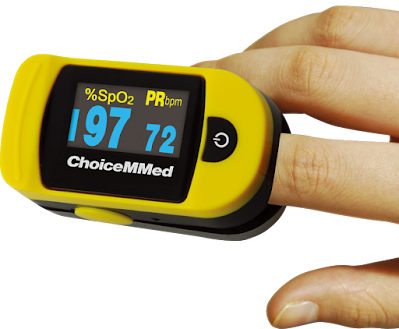Pulse Oximeter - Beneficial or Harmful?
What Is Pulse Oximeter:
A pulse oximeter is a small device that looks sort of like a chip clip or a big clothes pin.
How Pulse Oximeter Works:
1.When you insert your finger into a pulse oximeter.Within seconds ,
it lights up with numbers indicating your blood oxygen level and
heart rate.
2.It beams different wavelengths of light through your finger,
measuring the amount of oxygen.It does this by measuring changes of light absorption in oxygenated or deoxygenated blood.
3.It’s targeting hemoglobin, a protein molecule in your blood that carries oxygen. Hemoglobin absorbs different amounts and wavelengths of light depending on the level of oxygen it’s carrying.
4.Pulse oximeter will give a numerical reading — a percentage that indicates the level of oxygen saturation in your blood.
How should we use A Pulse Oximeter:
To get the most accurate reading on a pulse oximeter,there are some steps:
1.A clip-like device will be placed on your finger, earlobe, or toe.
You may feel a small amount of pressure, but there is no pain or pinching.
2.You may be asked to remove your fingernail polish if it’s being attached to a finger.
3.You’ll keep the probe on for as long as needed to monitor your pulse and oxygen saturation.
4.Once the test is over, the clip or probe will be removed.
Normal Readings Of Pulse Oximeter:
1.The pulse oximeter will be able to tell you your oxygen saturation levels along with your heart rate.
2.Most healthy people will get an oxygen reading around 95 to 98 percent.
3.A normal resting heart rate for adults ranges from about 60 to 100 beats per minute.
When should we use A Pulse Oximeter:
1.The purpose of pulse oximetry is to check how well your heart is pumping oxygen through your body.
2.It may be used to monitor the health of individuals with any type of condition that can affect blood oxygen levels,especially while they’re in the hospital.
These conditions include:
-Chronic obstructive pulmonary disease (COPD)
-Asthma
-Pneumonia
-Lung cancer
-Anemia
-Heart attack or heart failure
-Congenital heart defects
3.There are a number of different commonly used cases for pulse oximetry, including:
-to assess how well a new lung medication is working
-to evaluate whether someone needs help breathing
-to evaluate how helpful a ventilator is
-to monitor oxygen levels during or after surgical procedures that require sedation
-to determine how effective supplemental oxygen therapy is,especially when treatment is new
-to assess someone’s ability to tolerate increased physical activity
-to evaluate whether someone momentarily stops breathing while sleeping — like in cases of sleep apnea — during a sleep study
4.Role of using Pulse Oximeter in COVID-19:
It painlessly checks blood oxygen level,which can be affected by lung diseases such as COVID-19.
Warning of using Pulse Oximeter:
1.There are a variety of conditions that can affect PO2 levels shows low SPO2 levels including:
Asthma, pneumonia, Chronic Obstructive Pulmonary Disease (COPD), lung cancer, chemotherapy, and even mild cold or flu can adversely affect oxygen saturation and should be treated.
2.Marathon runners often have a heart rate lower than 60 but an oxygen saturation over 97 percent on room air, considered “normal”
3.Babies and toddlers often have a heart rate over 100 but normal oxygen levels, considered “normal”.
4. pulse oximeter is not the best tool for measuring oxygen saturation in heavy smokers.Carbon dioxide can also interfere with an accurate reading.
Pulse oximetry is a quick, noninvasive, and completely painless test.A pulse oximeter still provides a look at your overall health that can be crucial in making treatment decisions.







0 Comments
if you have any doubt,please let me know